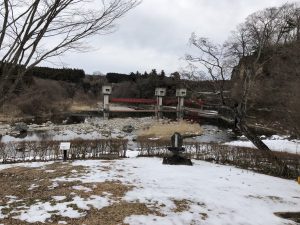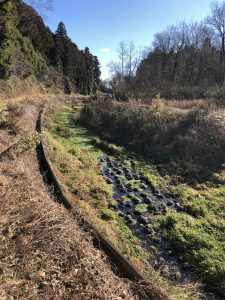Within our first week at the Asian Rural Institute (ARI), we were taken on a tour of the Nasu canal and learned of its importance. The Nasu canal provides accessible water to the adjacent Nasu plain which enables farmers to irrigate and farm the land. But this was not always the case. Up until the late 19th century, the Nasu plain used to be barren and desolate; little to nothing could be grown because there was no easily accessible water. Even though there were snowy mountains that fed into near by rivers, the water would go underground, creating waterless rivers all over the plain. The plain remained uninhabitable for the most part since farming there was very difficult without water.
It was not till 1885 when two, local men proposed to create a canal that would divert water from a river up in the mountains and would funnel it into four smaller canals that would cross the Nasu plain. The smaller canals would provide accessible water to farmers and would make agriculture production possible! Despite a lack of government consent and funding, the two men decided to fund the project themselves and started recruiting workers to start building the canal. Digging out the canal was very difficult work and there were technical difficulties along the way, but the problems were overcome and the canal was built within 5 months. The main canal successfully diverted water to the smaller canals which provided accessible water to farmers all over the Nasu plain. More farmers and citizens came once they heard that there was water that they could use to farm and live off of.

The head of the Nasu canal where it meets with the Naka-gawa river

The main canal which supplies water to four other canals running perpendicular to it.
A central theme to our class here in Japan is understanding nature in context to local areas as well as how people interact with it. We have read about the past issues of environmental degradation via industrial pollution during the 20th century in Japan. There’s a long history of man made altercations of nature that have had negative consequences on both the environment as well as people. Yet the story of the Nasu canal reminds us that not all manmade altercations and interactions with nature have to have negative consequences. By diverting a part of the river’s water into the Nasu canal, hundreds of thousands of acres of land can be irrigated and farmed, creating jobs and a thriving community. Here nature is not harmed, rather it is added upon by promoting the growth of produce and crops; this adds diversity to this ecosystem that used to be just barren plain. The story of the Nasu canal holds testamate that mankind and nature can harmoniously coexist and benefit from each other.

A side canal near ARI. The water enables for vegetation to flourish
Recent Comments